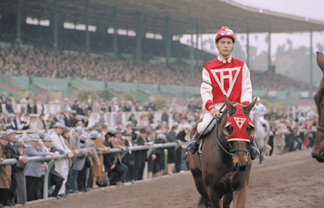Win, Place, or Show
Judge for yourself
By Victoria Alexander

See that guy in blue? No, the other one. That's me.
Seabiscuit is really a metaphor for America facing the future during the Great Depression. Or Seabiscuit is about the beginning of the automobile industry? Or poverty in 1930 when Americans had nothing to eat and even less to do? That's a lot of important history to plow through to get to Seabiscuit.
Entertainment Weekly, suggests Seabiscuit is "Oscar bait." Okayyeah. Everything that could be wrong about a movie is evident here. Where to begin? Well, let's start with the story of an anorexic jockey with wild red hair styled circa 1930. It's clear star Tobey Maguire does not like his look and neither does his screenwriter/director (Gary Ross). Tobey looks starved and ill. His skin looks awful. Whenever possible, the camera ignores him.
The movie, after a verbose history lesson, begins with the career of Seabiscuit's future owner Charles Howard (Jeff Bridges). He starts out dirt poor, selling and repairing bicycles, but begins making cars and he becomes wildly rich.
After the Stock Market Crash, Americans were plunged into poverty. Let's not bore you with the details learned watching Seabiscuit. Let's bore you with the details of Johnny "Red" Pollard growing up in a large family where his mother treated his father like a god and all the children quoted Shakespeare to big applause at the dinner table. As the family is homeless because of the Crash, Pollard's parents farm him out to someone who will feed him.
Then there is somber trainer Tom Smith (Chris Cooper) who finds a damaged small bay named Seabiscuit. As he and Howard keep saying, over and over again, "You don't throw a whole life away just because it's banged up a little." This is the scene shown when all the critics introduce their fawning setups, while they reminisce about how their fathers or grandfathers listened to Seabiscuit's racing victory on the radio back in the day, and compare it to remembering where they were when Kennedy was shot.
Meanwhile, Pollard is a tough little guy prizefighting and causing mayhem. For the rest of this long movie we find out absolutely nothing about Pollard except he's not gay. In one isolated scene he pays a prostitute in Mexico to have sex with him. Listen up people, "You don't throw a whole life away just because it's banged up a little."
The movie gleans some insight about Pollard as a jockey on top of the greatest horse that turned America around and brought light and life into homes. Seabiscuit becomes a huge star, but Pollard still lives in the horse's stall on Howard's farm. He doesn't get accolades or women. He keeps wearing the same clothes.
Finally, Howard wants Seabiscuit to run against Triple Crown winner War Admiral. But, in a fascinating psychological moment not explored in any detail, days before his major race, Pollard helps a friend with his wild horse and destroys his leg. Pollard is not self-destructive, he just had an accident that changed his life. He cannot ride Seabiscuit in the race of their lives! Star jockey George Woolf (Gary Stevens) takes his place on top of Seabiscuit while Pollard listens to the race from his hospital bed. It's as if Rocky got lost on his way to the fight with Apollo Creed.
The most important race of the movie and the star is laid up in the hospital! Did you happen to see Hall of Fame jockey Gary Stevens in his glamour photo in Vanity Fair's August 2003 issue? Yes Stevens is tiny, but he demonstrates a self-aware sex appeal of being a star in his field. Apparently Pollard was never a confident star.
With the camera studiously avoiding Maguire and Cooper scowling gravely, Jeff Bridges knows the scenery is his for the chewing.
He fills the screen with his big, moneyed presence as extravagant Charles Howard. Bridges is also savvy enough to realize he's the only sex symbol in the 140 minute movie. He's fat, has jowls, and is old but, at least he expresses joy and charisma. The film is really all about him.
If you intend to see Seabiscuit because of the special bird's eye view of horse racing, yes, the camera work is impressive. But be warned. Mostly it is shot from behind the jockeys. It's not the most attractive view.
As they always say of racing, if you ain't the lead horse, the view never changes.
HOME | THIS ISSUE | ACE ARCHIVES